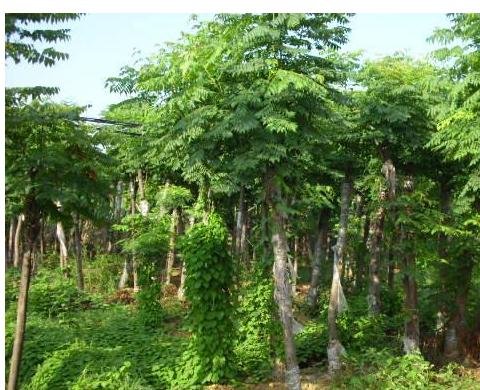[difference between shrubs and trees] different pruning methods for shrubs and trees
The difference between shrubs and trees can be recognized at a glance, but some species with short trunks are also called small trees, such as crape myrtle.

I. the difference between shrubs and trees
1, height gap: trees, tall trees, generally between 6 meters to 10 meters, with obvious tall trunk. According to its height, it can be divided into Weiqiao (more than 31 meters), Big Joe (21-30 meters), Zhong Qiao (11-20 meters), Xiao Qiao (6-10 meters) and other four levels. Shrubs having a short tree (usually below 6 m) and a low trunk.
2, the difference of plant stem shape: the woody plant that has an upright trunk and is more than 5 meters high is called a tree. The shrub trunk is not obvious, and the woody plants that often send out multiple branches at the base are called shrubs, such as rose, dragon boat flower, Yingshanhong, peony and so on.
3. The difference between the trunk: Arbor refers to the tall tree, which has an independent trunk from the root, and there is a clear distinction between the trunk and the crown. Shrub means that the tree is small and has no obvious trunk, and there are many branches or clumps near the ground.

Second, common shrub pruning
Hibiscus: generally pruned into small trees, should retain a main branch when planting, cut off the rest of the tufted branches. Do not leave the trunk too high, let the lateral branches grow from about 30 cm, each plant leaves 5-8 lateral branches, while retaining a central leading branch, at this time, the branches are upright upward growth, clasping very tight. In order to enlarge the crown width, the lateral branches should be truncated in early spring every year to promote axillary bud germination and form more new lateral branches. With the increase of the number of internal branches, the lateral main branches continue to open outward, and the number of flowering will increase year by year.
Crape myrtle: pruning is mainly in the old branches that have already flowered, and must be carried out in the spring before germination after defoliation. All the branches that have flowered and borne fruit in the summer and autumn of that year should be cut short by about 2/3, leaving only 3-4 pairs of buds at the base, and the pile length should be about 8-10 cm.

Third, common tree pruning
Ginkgo biloba: it maintains a conical crown from infancy to maturity. Young seedlings are easy to form a natural conical crown, the central trunk grows and develops nearly whorled branches, and many branches grow around the same part, which is similar to the phenomenon of "pinching the neck". The number of main branches is generally retained 3-4, and ensure that the retained main branches are scattered up and down-short and erect lateral branches promote the growth balance of the main branches; on the basis of maintaining a certain height, cut off competitive branches, dead branches, drooping old branches, overlapping branches, whorled branches, and parallel branches. Gradually adjust the excessive main branches on the grain spindle and let them be evenly distributed on the central trunk. There is a certain gap between the branches and the left and right flutes.
Robinia pseudoacacia: the strong and straight branches growing upward are selected in the upper part of the central trunk, the thin and curved parts of the tip are cut off at the reserved shearing buds, and several lateral buds are erased at the lower part of the shearing buds, which can avoid the emergence of competitive branches in advance. When the trunk reaches a certain height, 2-3 main branches are left. The 30cm length of each main branch was truncated. It will be trimmed every 2-3 years afterwards. Pruning according to the cup shape to make it a round head, this kind of plastic seedlings are shorter. When the trunk reaches a certain height, 2-3 main branches are left-during the growing period, the trunk is coring for 2-3 times, and one node of the trunk grows upward each year, leaving two main branches-but the lower part of the trunk should be pruned accordingly, so that the tree can control the distribution of the main branches through the central trunk in a certain period of time to maintain the whole leaf area.

The difference between shrubs and trees makes them have different uses in landscape design. We must distinguish them and treat them separately, and then make a reasonable allocation of the two, so as to create the most reasonable, decent and beautiful landscape.
Related
- Wuhan Hospital Iron Tree Blooming Result Was Instantly Frightened by the Gardener Master
- Which variety of camellia is the most fragrant and best? Which one do you like best?
- What is the small blue coat, the breeding methods and matters needing attention of the succulent plant
- Dormancy time and maintenance management of succulent plants during dormancy
- Minas succulent how to raise, Minas succulent plant pictures
- What are the varieties of winter succulent plants
- How to raise succulent plants in twelve rolls? let's take a look at some experience of breeding twelve rolls.
- Attention should be paid to water control for succulent plants during dormant period (winter and summer)
- Watering experience of twelve rolls of succulent plants
- Techniques for fertilizing succulent plants. An article will let you know how to fertilize succulent plants.



